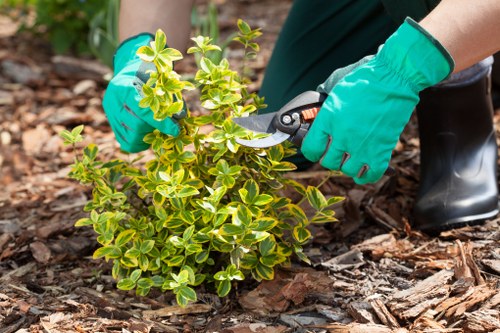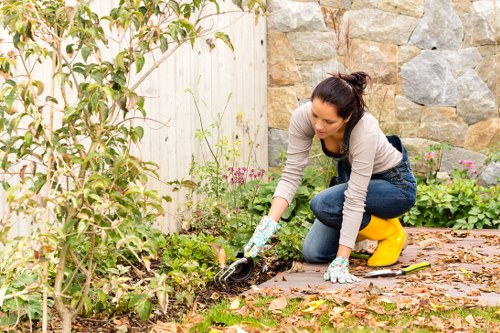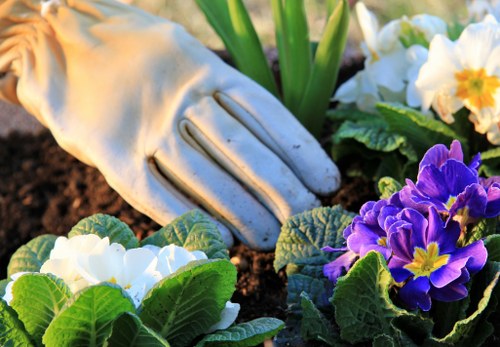Effective Driveway Algae Removal in Burnt Oak

Algae growth on driveways can be both unsightly and slippery, posing hazards to homeowners in Burnt Oak. Understanding the best methods for removing algae not only enhances curb appeal but also ensures safety around your property.
Burnt Oak's climate, characterized by its humidity and rainfall, creates an ideal environment for algae to thrive. This guide provides comprehensive strategies to tackle driveway algae effectively.
Before diving into removal techniques, it's essential to identify the type of algae affecting your driveway. Different algae types may require specific treatments to ensure complete eradication.
Understanding Algae Growth on Driveways

Algae are simple, plant-like organisms that thrive in moist environments. On driveways, they appear as green or black stains, often due to the presence of moss or mold. These organisms feed on organic matter and can quickly spread if left untreated.
The presence of algae on your driveway can lead to structural damage over time. The roots of certain moss species can penetrate cracks, enlarging them and making your driveway more susceptible to erosion and water damage.
Regular maintenance is crucial in preventing algae growth. Implementing preventive measures can save you time and money in the long run by reducing the need for extensive cleaning and repairs.
Top Methods for Algae Removal

There are several effective methods for removing algae from driveways in Burnt Oak. These include chemical treatments, natural remedies, and mechanical cleaning techniques. Each method has its advantages and considerations, depending on the severity of the infestation and your personal preferences.
Chemical Treatments: Commercial algae removers containing bleach or other disinfectants can be highly effective. However, they require careful handling to avoid damage to surrounding vegetation and ensure personal safety.
Natural Remedies: Solutions like vinegar, baking soda, and hydrogen peroxide offer eco-friendly alternatives. These methods are generally safer for the environment but may require more effort to achieve the desired results.
Step-by-Step Guide to Removing Algae

Follow these steps to effectively remove algae from your driveway:
- Preparation: Clear the driveway of any debris and sweep away loose algae.
- Choose Your Treatment: Decide between chemical or natural cleaning agents based on your preference and the extent of algae growth.
- Application: Apply the chosen treatment evenly across the affected areas.
- Scrubbing: Use a stiff brush to scrub the driveway, ensuring the treatment penetrates the algae.
- Rinsing: Thoroughly rinse the driveway with water to remove residual treatment and loosened algae.
- Prevention: Implement measures such as sealing cracks and improving drainage to prevent future growth.
Preventing Future Algae Growth

Preventing algae from returning to your driveway involves several proactive steps. Ensuring proper drainage, reducing moisture buildup, and maintaining cleanliness are key factors in discouraging algae growth.
Consider sealing your driveway to create a protective barrier against moisture. Regularly inspect and repair any cracks or damages to prevent algae from establishing footholds.
Additionally, trimming nearby vegetation can reduce shade and moisture accumulation, making the environment less hospitable for algae.
Local Expertise in Burnt Oak
Burnt Oak and its surrounding areas offer a range of professional services specializing in driveway algae removal. Local experts understand the unique climate and conditions that contribute to algae growth, allowing them to provide tailored solutions for homeowners.
Hiring a local service ensures that you receive efficient and effective treatment, utilizing methods that are best suited for your specific driveway material and the severity of the algae infestation.
Understanding the Costs Involved
The cost of algae removal in Burnt Oak varies based on the size of your driveway, the extent of algae growth, and the method chosen for removal. Chemical treatments may offer a cost-effective solution, while professional services might incur higher fees but provide comprehensive care.
Investing in regular maintenance can mitigate long-term costs by preventing severe damage and reducing the need for expensive repairs or extensive cleaning procedures.
It's advisable to obtain quotes from multiple service providers to ensure you receive competitive pricing and the best value for your investment.
Eco-Friendly Algae Removal Options
For environmentally conscious homeowners, eco-friendly algae removal options are available. These methods minimize the impact on surrounding flora and fauna while effectively eliminating algae from your driveway.
Natural cleaning agents like vinegar and baking soda are popular choices. They are non-toxic and safe for use around pets and children, making them ideal for residential areas.
Additionally, professional services may offer green solutions that utilize sustainable practices, ensuring both the health of your driveway and the environment.
Expert Tips for Maintaining a Clean Driveway
Maintaining a clean driveway requires consistent effort and attention. Here are some expert tips to help keep your driveway algae-free:
- Regularly sweep your driveway to remove debris that can hold moisture.
- Seal cracks and joints to prevent water infiltration and algae growth.
- Ensure proper drainage to avoid water pooling on the surface.
- Trim vegetation around the driveway to reduce shade and moisture retention.
- Apply preventative treatments periodically to keep algae at bay.
Implementing these practices can significantly reduce the likelihood of algae returning, ensuring your driveway remains clean and safe.
Consistency is key; incorporating these maintenance tasks into your regular home upkeep routine will yield the best results over time.
Choosing the Right Professional Service
Selecting a reputable professional for algae removal is crucial for achieving optimal results. When evaluating service providers in Burnt Oak, consider factors such as experience, customer reviews, and the range of services offered.
A trusted professional will assess your driveway's condition, recommend the most effective treatment, and ensure that the job is done efficiently and safely.
Don't hesitate to ask for references or inquire about the methods they use to ensure they align with your preferences and standards.
Long-Term Benefits of Algae Removal
Removing algae from your driveway offers several long-term benefits. Beyond improving the aesthetic appeal of your property, it enhances safety by reducing slip hazards and prevents structural damage caused by persistent algae growth.
Maintaining a clean driveway can also increase your property's value and curb appeal, making it more attractive to potential buyers if you ever decide to sell.
Ultimately, regular algae removal is an investment in the longevity and beauty of your driveway, ensuring it remains a functional and attractive part of your home.
Advanced Solutions for Persistent Algae
For cases where traditional removal methods fall short, advanced solutions such as pressure washing or professional-grade treatments may be necessary. These methods offer a deeper clean, tackling stubborn algae and ensuring a thorough restoration of your driveway.
Pressure washing, for example, uses high-pressure water jets to remove deeply embedded algae, providing a fresh and clean surface.
Professional-grade treatments may include specialized chemicals that target specific types of algae, ensuring complete eradication and preventing future growth.
Safety Precautions
When removing algae, it's important to prioritize safety. Whether you're using chemical treatments or natural remedies, always follow the manufacturer's instructions and wear appropriate protective gear.
Ensure proper ventilation when applying chemical solutions and keep children and pets away from treated areas until it's safe.
Additionally, be cautious when using tools like brushes or pressure washers to avoid injury or accidental damage to your driveway.
Conclusion
Driveway algae removal in Burnt Oak is essential for maintaining a safe and visually appealing home. By understanding the causes of algae growth and implementing effective removal and prevention strategies, homeowners can protect their driveways from unsightly and hazardous algae infestations.
Whether you choose DIY methods or seek professional assistance, the key to successful algae management lies in consistent maintenance and proactive care.
Take action today to ensure your driveway remains clean, safe, and beautiful for years to come.
Frequently Asked Questions
1. What causes algae to grow on driveways?
Algae thrive in moist, shaded environments. In Burnt Oak, the combination of humidity and occasional rainfall creates ideal conditions for algae to develop on driveways.
2. Can I remove driveway algae myself, or should I hire a professional?
Small to moderate algae growth can often be managed with DIY methods using natural or chemical treatments. However, for extensive infestations, hiring a professional ensures thorough removal and prevents recurrence.
3. Are chemical algae removers safe for the environment?
Many chemical algae removers contain harsh substances that can harm nearby plants and animals if not used correctly. It's important to follow the manufacturer's instructions and consider eco-friendly alternatives when possible.
4. How often should I treat my driveway to prevent algae growth?
Regular maintenance is key. It's recommended to treat your driveway at least twice a year, typically in the spring and fall, to prevent algae from establishing itself.
5. What types of driveways are more prone to algae growth?
Driveways made of porous materials like asphalt and concrete are more susceptible to algae growth due to their ability to retain moisture. Proper sealing and maintenance can help mitigate this risk.


